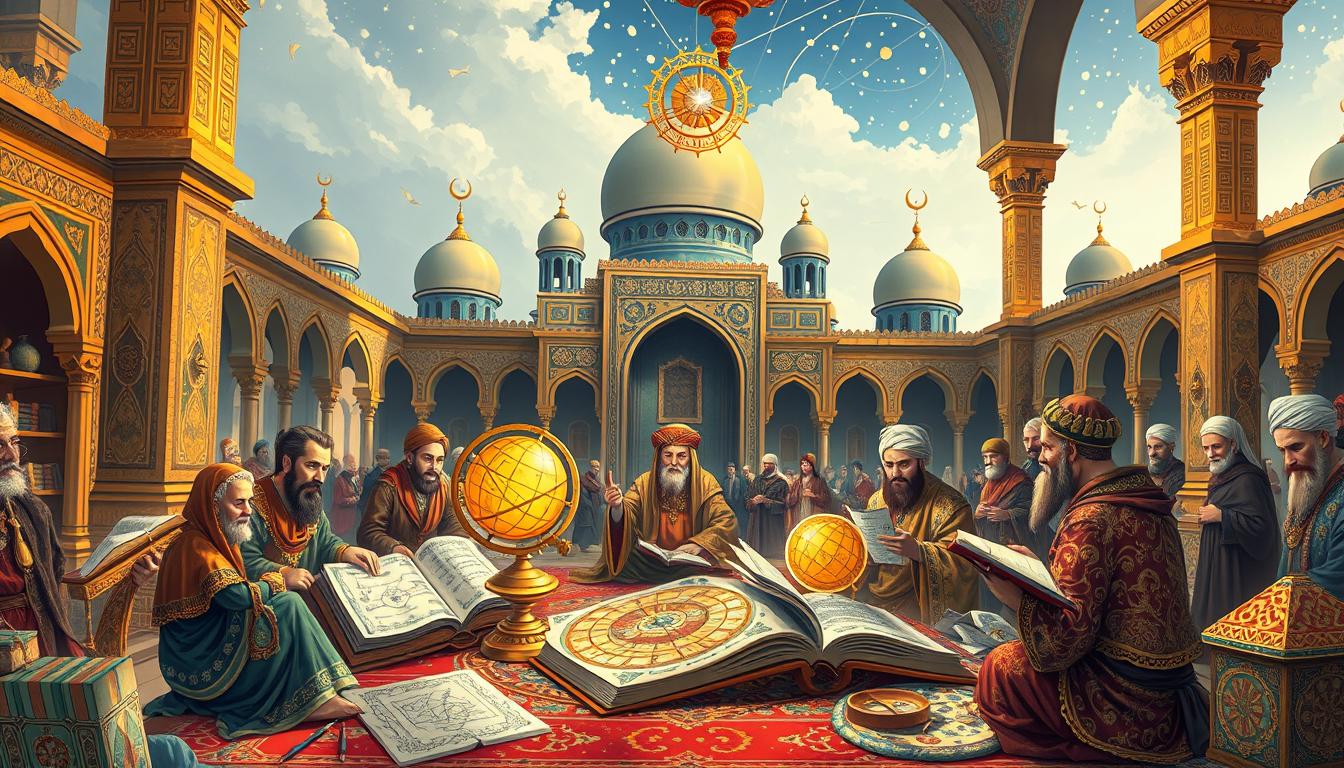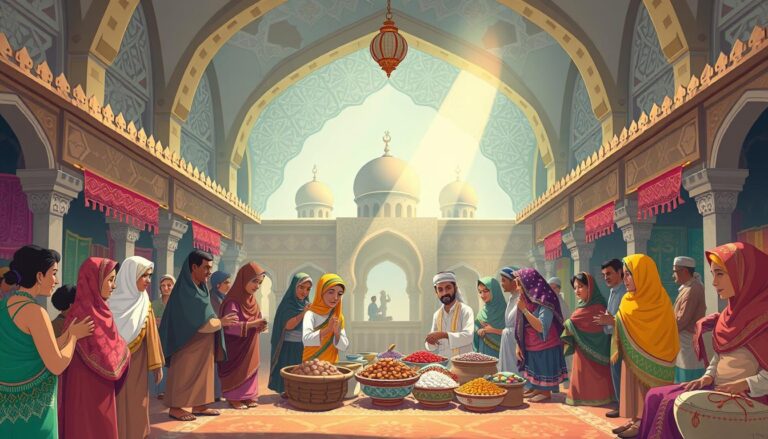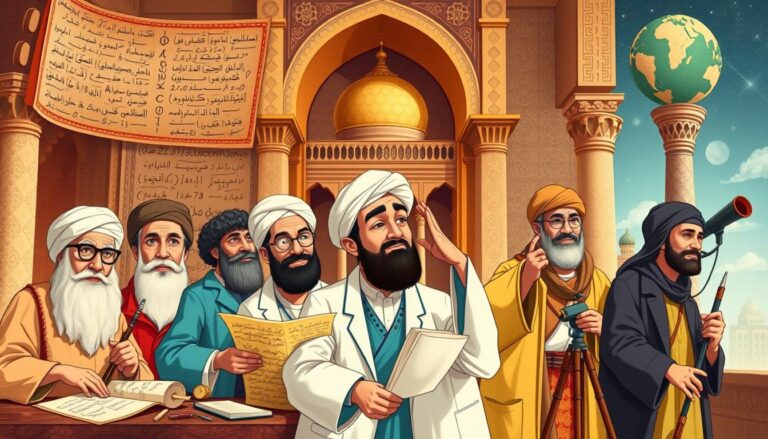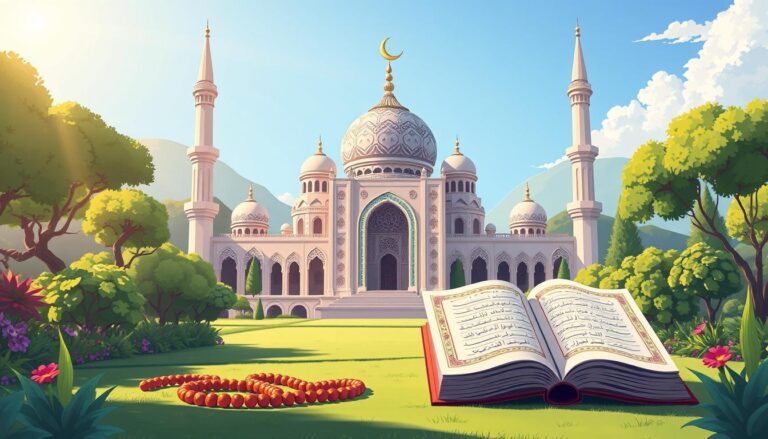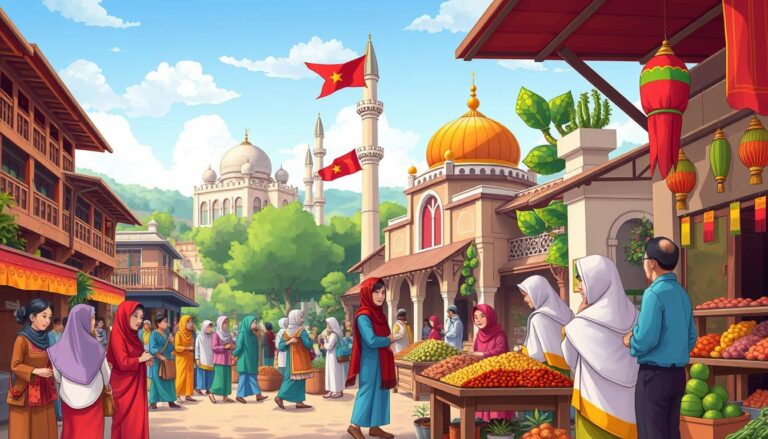10 Contributions of Muslims to Modern Science and Art
Ever wondered how the number zero came to be? Or who started algebra, a subject that’s both intriguing and challenging? The answers are found in the rich history of Islamic science and the genius of Muslim inventors during the Islamic Golden Age.
Between the 8th and 15th centuries, the Islamic world was a hub of knowledge and innovation. During this time, Muslim scholars made key discoveries and inventions. These contributions shaped science, mathematics, medicine, and art, leaving a lasting impact on our world today.
Did you know the word “science” is mentioned 779 times in the Quran? This shows how much Islamic teachings value knowledge. Prophet Muhammad encouraged learning, saying that Allah, His angels, and all beings bless those who share useful knowledge.
Key Takeaways
- Muslim scholars significantly contributed to Mathematics, Physics, and Medicine
- The Islamic Golden Age lasted over two centuries, producing numerous scientific texts
- Muslims developed the symbol for zero and the decimal system
- Al-Khwarizmi’s work on algebra remained a key textbook in European universities until the 16th century
- Islamic ophthalmologists described cataract surgery as early as 1010
- Arabic was the courtly language of southern Spain until the 15th century
- Islamic art and architecture influenced European styles, including the Palatine Chapel in Sicily
Introduction to Islamic Golden Age
The Islamic Golden Age was a time of great scientific and cultural growth. Muslim scholars made many important discoveries. These discoveries still influence science and art today.
Timeline and Geographical Scope
This era lasted from the 8th to the 13th century. It covered a wide area, from Spain to Central Asia. Cities like Baghdad, Cairo, and Córdoba became centers of learning.
Factors Driving Advancements
Several things helped make this period so special:
- Religious encouragement of learning and knowledge-seeking
- Political support from caliphs who valued scholarship
- Cultural exchange with diverse civilizations
- Introduction of paper in the 10th century, democratizing information
- Establishment of institutions like the House of Wisdom in Baghdad
The House of Wisdom, started in 825 by Caliph al-Mansur, was key. It helped preserve and translate ancient knowledge. Scholars from different backgrounds worked together here, making big contributions to science and art.
“Seek knowledge from the cradle to the grave.” – Prophet Muhammad
During this time, Muslim scholars were paid well, like today’s athletes. This period set the stage for many modern scientific and artistic ideas. It shaped the world we live in today.
The Foundations of Modern Mathematics
The Golden Age of Islamic Civilization lasted from the 7th to the 15th centuries. During this time, Arabic mathematics saw huge leaps forward. Muslim scholars created the basis for many mathematical innovations we still use today.
Algebra and its origins
Muhammad bin Musa al-Khwarizmi was born in 780 A.D. He is credited with starting the subject of algebra. His work on solving equations changed mathematics forever. The word “algebra” comes from the Arabic “al-jabr,” meaning “restoration” or “completion.”
Al-Khwarizmi’s book introduced systematic ways to solve linear and quadratic equations. This work was a key step in the development of mathematics.
Trigonometry and advanced calculations
Muslim mathematicians made big steps in trigonometry. Abu Wafa Muhammad al-Buzanji, born in 940 A.D., created a new way to make sine tables. Abu Abdullah al-Battani also worked on trigonometry, introducing the concept of cotangent and its table in degrees.
Ghiyath al-Din al-Kashani made a huge achievement in 1424. He calculated pi to sixteen decimal places, showing the accuracy of Arabic math.
“Mathematics is the language with which God has written the universe.” – Galileo Galilei
These efforts in algebra, trigonometry, and advanced calculations are the foundation of modern math. The work of these geniuses still shapes math studies around the world.
Astronomical Discoveries and Innovations
Muslim astronomers made huge strides in the Islamic Golden Age. They built advanced observatories and created precise tools. These changes greatly improved our view of the universe.
The astrolabe, invented in the 8th century, was a game-changer. It helped measure stars and planets accurately. This tool was key for navigation and keeping time. It helped Muslim astronomers make detailed star charts and better models of planets.
Al-Battani was a leading astronomer. He made very accurate calculations of the solar year. Nasir al-Din al-Tusi also made big contributions, creating complex models for planets.
“The stars are the aristocrats of the sky.” – Al-Battani
These astronomers set the stage for modern astronomy. Their work inspired European scientists for many years. Their innovations still shape our understanding of the universe today.
- Muslim astronomers improved upon Ptolemy’s work
- They created more accurate star catalogs
- Their observatories featured advanced instruments
- Their discoveries influenced European astronomy
Advancements in Medical Science
Islamic medicine changed healthcare during the Golden Age of Islam. Muslim doctors made big steps in medicine that we still use today. They worked on surgeries, medicines, and even hospital systems.
Surgical Techniques and Instruments
Al-Zahrawi, known as the father of modern surgery, wrote a huge book on surgery. He came up with new kinds of stitches and tools that we still use. Muslim scholars also worked on understanding the body and found ways to make surgery less painful.
Pharmacology and Treatment Methods
Muslim scientists found important chemicals like potash and alcohol. These finds helped make medicines better. Ibn Sina, a famous doctor, wrote a book called the Canon of Medicine. It’s still a big deal in medical history.
Hospital Systems and Medical Education
The first hospital was built in Baghdad in 706 AC. This started a new chapter in healthcare. Every big city in the Islamic world had great hospitals. These places were for learning and studying medicine.
Ibn Sina’s Al-Qanun fi al-Tibb was a key book in European schools for over 700 years. It shows how Islamic medicine has shaped healthcare worldwide.
“The science of medicine is long, and life is short; the art is long, the opportunity fleeting, experience deceptive, and judgment difficult.” – Ibn Sina
10 Contributions of Muslims to Modern Science and Art
The Islamic Golden Age was a time of great progress. Muslim scholars made many important discoveries and inventions. Their work still shapes our world.
Optics and the Camera Obscura
Ibn al-Haytham changed the field of optics. He explained how we see and described the camera obscura. His work helped create modern cameras and optical tools.
Flying Machine Concepts
Abbas ibn Firnas wanted to fly. In the 9th century, he built an early flying machine. Though it didn’t work, his ideas helped others dream of flight.
Development of the Astrolabe
Muslim astronomers improved the astrolabe. This tool was key for navigation and keeping time. It helped explorers and scientists alike.
Architectural Innovations
Islamic architecture introduced new ideas. Domes, pointed arches, and geometric patterns became common. These designs influenced buildings around the world.
“The contributions of Muslim scholars during the Islamic Golden Age were truly remarkable. Their work in optics, aviation, astronomy, and architecture laid the groundwork for many modern scientific and artistic advancements.”
Muslim scholars left a lasting legacy. Their discoveries and inventions still inspire us today.
Islamic Influence on Art and Architecture
The Golden Age of Islam, from the 7th to the 15th century, was a time of great art and architecture. Islamic art became known for its detailed geometric patterns, calligraphy, and arabesque designs. These elements combined beauty with practicality, creating a unique style that still fascinates people today.
During this time, architectural innovations changed the world of design forever. The use of dome structures, pointed arches, and muqarnas (honeycomb vaulting) improved building techniques. These innovations made buildings stronger and more visually appealing.
Some of the most impressive examples of Islamic architecture include:
- The Alhambra in Spain
- The Taj Mahal in India
- The Dome of the Rock in Jerusalem
These buildings showcase the incredible engineering and artistic talent of Islamic architects. They perfectly combine beauty and function, creating spaces that evoke wonder and respect.
Islamic art’s influence goes beyond buildings. Calligraphy, a key part of Islamic art, turns written words into art. This tradition comes from the importance of the Quran and its teachings in Islamic culture.
The cultural heritage of Islamic art and architecture still inspires today’s designers and artists. Its focus on geometric patterns and symmetry is seen in modern minimalist designs. Islamic art connects past and present, bringing different cultures together through shared appreciation of beauty and skill.
Preservation and Translation of Ancient Knowledge
The Islamic Golden Age was a time of great progress in saving and sharing knowledge. Scholars from many places worked hard to keep old wisdom safe and pass it on to others. This era was a key moment in the history of science and learning.
The House of Wisdom: A Beacon of Learning
Baghdad’s House of Wisdom was a place of deep learning and great achievement. Started in the 8th century, it became the center of the translation movement. Scholars from different cultures came together to translate texts from Greek, Persian, and Indian into Arabic.
The translation movement was key in keeping knowledge alive. It brought old texts to more people, sparking new ideas and discoveries. This effort saved many works from being lost and opened up new possibilities.
Impact on Global Knowledge
The effects of this cultural exchange were huge. Translated works made their way to Europe during the Renaissance, starting a scientific revolution. Arabic became a common language for scholars, connecting different cultures.
- Over 200 years after the Quran, Arabic became a rich international language for sciences
- Paper manufacturing spread across the Muslim empire, making knowledge sharing easier
- The Arabic script’s precision enhanced the preservation of texts
This time of intense learning set the stage for modern science and art. The work done in the Islamic Golden Age still influences how we see the world today.
Islamic Contributions to Music and Literature
Islamic music and Arabic literature have greatly influenced global culture. Muslim artists have enriched the arts for centuries. They introduced new instruments, poetic forms, and ways of telling stories.
Musical Innovations
Islamic music started around 610 CE and quickly spread wide. Muslim musicians brought the lute and rebab to Europe, starting the journey of modern string instruments. The complex modes in Islamic music, thanks to Bārbad, set a high standard in art.
The call to prayer, started by Muhammad in 622, is key in Islamic music. As Islam grew, new techniques, better instruments, and complex musical forms emerged.
Literary Treasures
Arabic literature bloomed during the Islamic Golden Age. Poetry and stories were closely linked with music in Bedouin culture. This bond continued in Islamic society, with music enhancing poetic recitation.
- The One Thousand and One Nights (Arabian Nights) became a globally influential work
- Persian poets like Rumi and Omar Khayyam made lasting contributions to world literature
- Sophisticated literary salons held contests to reveal and reward the best talents
These influences still shape modern art and literature. They show the lasting impact of Islamic creativity and innovation.
Conclusion
The Islamic scientific legacy has made a lasting impact on our world. From the 7th to the 15th century, Muslim scholars and innovators made huge strides in many fields. They helped pull Europe out of the Dark Ages and into the Renaissance.
This golden era saw a lot of cultural exchange. The House of Wisdom in Baghdad was a key place for learning, translating works from many languages. Universities like Al-Qarawiyyin in Morocco and Al-Azhar in Egypt became centers of knowledge.
These places nurtured geniuses like Al-Khwarizmi, Ibn Al-Haytham, and Avicenna. They changed fields like algebra and optics. Their work still influences us today.
The Islamic scientific legacy still inspires us. The “1001 Inventions” exhibition, started in 2008, has shown Muslim contributions worldwide. It highlights everything from the Persian wheel to advanced surgery.
Looking back, we see the importance of curiosity, teamwork, and cultural exchange. They drive human progress and shape our world.
Source Links
- Galley4_4Rel.7-12-11-49
- Islam’s deep traditions of art and science have had a global influence
- Islamic Golden Age
- The Islamic Golden Age | World Civilization
- Microsoft Word – paper.DOC
- Contributions of Muslim Scholars: In The Field of Mathematics
- The greatest scientific advances from the Muslim world
- List of inventions in the medieval Islamic world
- Muslim Contributions in Medicine, Science & Technology
- Muslims Contribution To Science
- Arab Contributions to Civilization – ADC
- Islamic Contributions to Global Culture and Civilization
- Islamic arts | Characteristics, Calligraphy, Paintings, & Architecture | Britannica
- Islamic civilization and its cultural achievements | The Middle Ages Class Notes | Fiveable
- Muslim Contributions To Science and Art – Ghayb.com
- Islamic arts – Music History, Instruments, Genres | Britannica
- Islamic arts – Music, Instruments, Genres | Britannica
- Contributions of Islamic Civilization to the Modern World
- Science in the medieval Islamic world

